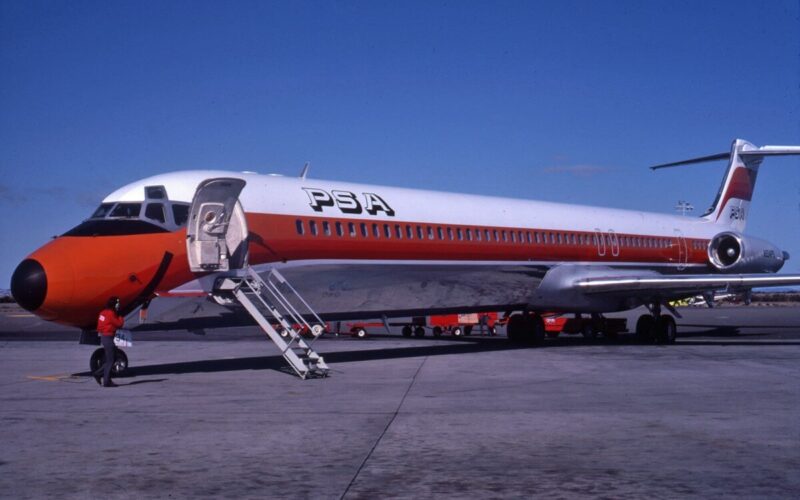Did you know that the low-cost carrier (LCC) business model first emerged in North America?
The term ‘low-cost carrier’ was first heard in the United States when the pioneering budget airline Pacific Southwest Airlines (LUV) (PSA) took to the skies in 1949. However, it wasn’t until Dallas-based Southwest Airlines (LUV) launched in 1973 that the US low-cost carrier market truly revolutionized.
The new low-fare airline market meant that the US full-service carriers (FSCs) lost a significant amount of market share because the budget airlines could offer lower prices.
March 2022 marks North America month at AeroTime so our team is focusing on the aviation industry in the region. Here, we look at the history of the first low-cost carrier in the United States.
Pacific Southwest Airlines – a pioneer in the LCC market
Pacific Southwest Airlines (LUV) was founded by Kenneth Giles Friedkin, a pilot and flight instructor, who also had a flight school and an unsuccessful charter airline called Friedkin Airlines.
Friedkin’s second carrier, Pacific Southwest Airlines (LUV), took off on May 6, 1949, with a $1,000-a-month leased Douglas DC-3 aircraft. The first flight from its base at San Diego Airport (SAN) (formerly known as Lindbergh airfield) accommodated 24 passengers who paid approximately just $15,00 per ticket.
At the time, the airline was operating weekly flights from San Diego to Oakland Airport (OAK) via Hollywood Burbank Airport (BUR).
As the pioneer of the low-fare business model, the launch of the airline wasn’t straightforward. PSA had no facilities of its own at San Diego airport. At the time, the airline bought a Marine Corps Latrine which served as the carrier’s first ticket reservation center. Also, during its first year of operation, the airline had no check-in area and had to weigh passenger baggage on bathroom scales.
Despite the difficulties, the first year of operation proved to be successful as the carrier reported profit.
The 1950s represented a significant period for the airline. By the middle of the decade, PSA had replaced its Douglas DC-3 fleet with newer Douglas DC-4 aircraft. By the end of the decade, PSA had expanded its services with flights from San Diego to San Fracisco and later to San Jose and Ontario. In 1959, the airline began replacing its DC-4s with 92-seat Lockheed L-188 Electras.
In 1963, Pacific Southwest Airlines (LUV) became a public corporation listed on the stock exchange, a move considered to be a big step forward for the carrier. In the 1960s, the airline continued to grow. PSA started to acquire Boeing 727s and later Boeing 737 jets.
Going forward, the airline experienced its first major accident in the 1970s. Flight 182, a Boeing 727, collided with a Cessna 172 while landing at San Diego Airport (SAN) in 1978. Both aircraft crashed, killing 144 people onboard and on the ground.
Pacific Southwest Airlines (LUV) initially operated as an intrastate airline only within the state of California. The strategy to be an intrastate carrier avoided high costs from the federal aviation regulation, which controlled prices and entry into other states.
However, the situation changed after the United States federal government passed the Airline Deregulation Act in 1978. The new law removed federal control over such areas as fares, routes, and market entry of new airlines, introducing a free market in the commercial airline industry and leading to an increase in the number of flights.
Consequently, PSA’s network stretched beyond California’s borders to include Reno, Las Vegas, Salt Lake City, Phoenix, Tucson, and Alburquerque. The airline even flew to the Mexican resort of Cabo San Lucas.
PSA was operational for 40 years. In 1986, the airline was purchased by USAir (later renamed US Airways) for $400 million. PSA was fully merged into USAir in 1988.
“We’ve had a long interest in expansion in California,” USAir Group chairman Edwin I. Colodny said, according to the Los Angeles Times in 1986. “PSA has the most modern fleet. That’s one of the real plusses.”
Hailed for its business model, PSA was an example for many airlines at the time. In 1973, Dallas-based low-cost carrier Southwest Airlines (LUV) was founded on PSA’s low-fare business model, the co-founder and former CEO Herb Kelleher said in an interview with the San Antonio Public Library Foundation in 2017.
With a fleet of more than 730 Boeing 737 aircraft, Southwest Airlines (LUV) is currently the largest low-cost carrier in the United States.

